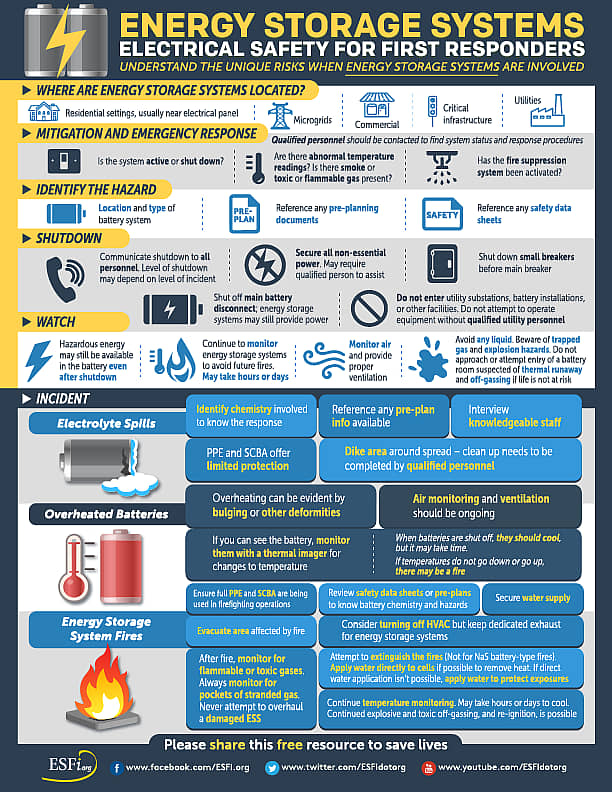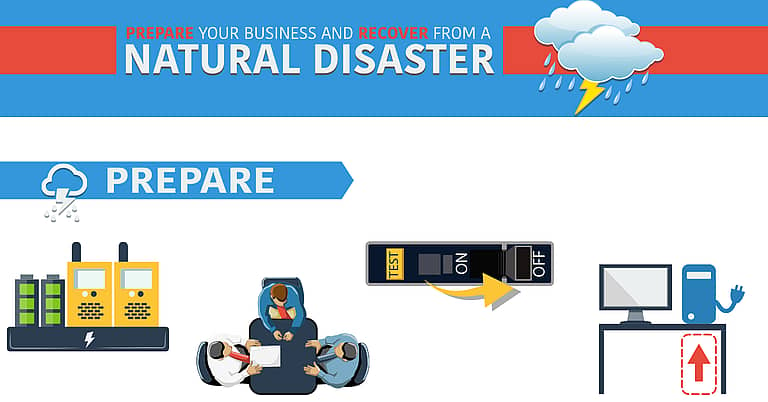Understand the Unique Risks When Energy Storage Systems (ESS) Are Involved
-
Where are Energy Storage Systems (ESS) Located
- Residential settings, usually near the electrical panel
- Microgrids
- Commercial
- Critical infrastructure
- Utilities
-
Mitigation and Emergency Response
- Is the system active or shut down?
- Are there abnormal temperature readings? Is there smoke or toxic or flammable gas present?
- Has the fire suppression system been activated?
- Qualified personnel should be contacted to find system status and response procedures
-
Identify the Hazard
- Location and type of battery systems
- Reference any pre-planning documents
- Reference any safety data sheets
-
Shutdown
- Communicate shutdown to all personnel. Level of shutdown may depend on level of incident
- Secure all non-essential power. May require a qualified person to assist
- Shut down small breakers before the main breaker
- Shut off main battery disconnect; energy storage systems may still provide power
- Do not enter utility substations, battery installations, or other facilities. Do not attempt to operate equipment without qualified utility personnel
-
Watch
- Hazardous energy may still be available in the battery even after shutdown
- Continue to monitor energy storage systems to avoid future fires. May take hours or days
- Monitor air and provide proper ventilation
- Avoid any liquid. Beware of trapped has and explosion hazards. Do not approach or attempt energy of a battery room suspected of thermal runaway and off-gassing if life is not at risk
-
Identify
- Electrolyte Spills
- Identify the chemistry involved to know the response
- Reference any pre-plan info available
- Interview knowledgeable staff
- PPE and SCBA offer limited protection
- Dike area around spread – clean up needs to be completed by qualified personnel
- Overheated Batteries
- Overheating can be evident by bulging or other deformities
- Air monitoring and ventilation should be ongoing
- If you can see the battery, monitor them with a thermal imager for changes in temperature
- When batteries are shut off, they should cool, but it may take time. If temperatures do not go down or go up, there may be a fire
- Energy Storage System Fires
- Ensure full PPE and SCBA are being used in firefighting operations
- Review safety data sheets or pre-plans to know battery chemistry and hazards
- Secure water supply
- Evacuate area affected by fire
- Consider turning off HVAC but keep dedicated exhaust for energy storage systems
- Attempt to extinguish the fires ( Not for NaS battery-type fires). Apply water directly to cells if possible to remove heat. If direct water application isn’t possible, apply water to protect exposures
- Continue temperature monitoring. May take hours or days to cool. Continued explosive and toxic off-gassing, and re-ignition, is possible
- After the fire, monitor for flammable or toxic gases. Always monitor for pockets of stranded gas. Never attempt to overhaul a damaged ESS
- Electrolyte Spills
Additional information may be found at NFPA Energy Storage Systems (ESS) and Solar Safety – Safety Training Program








